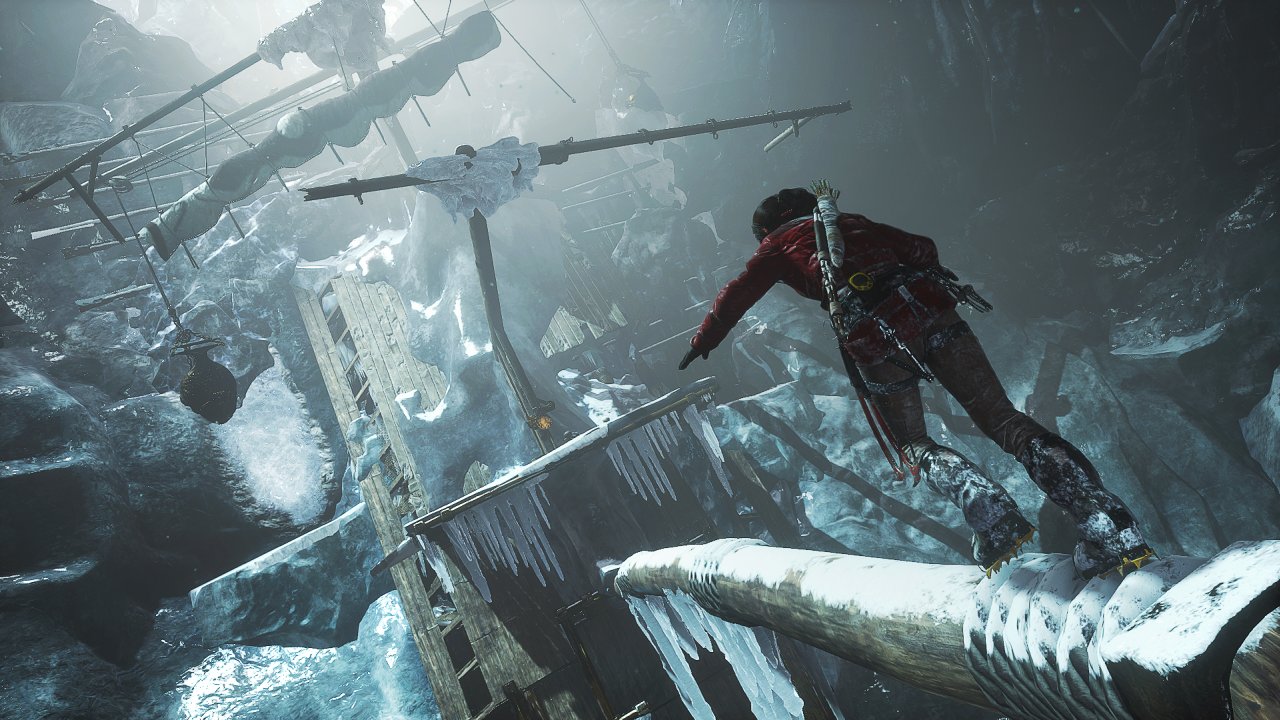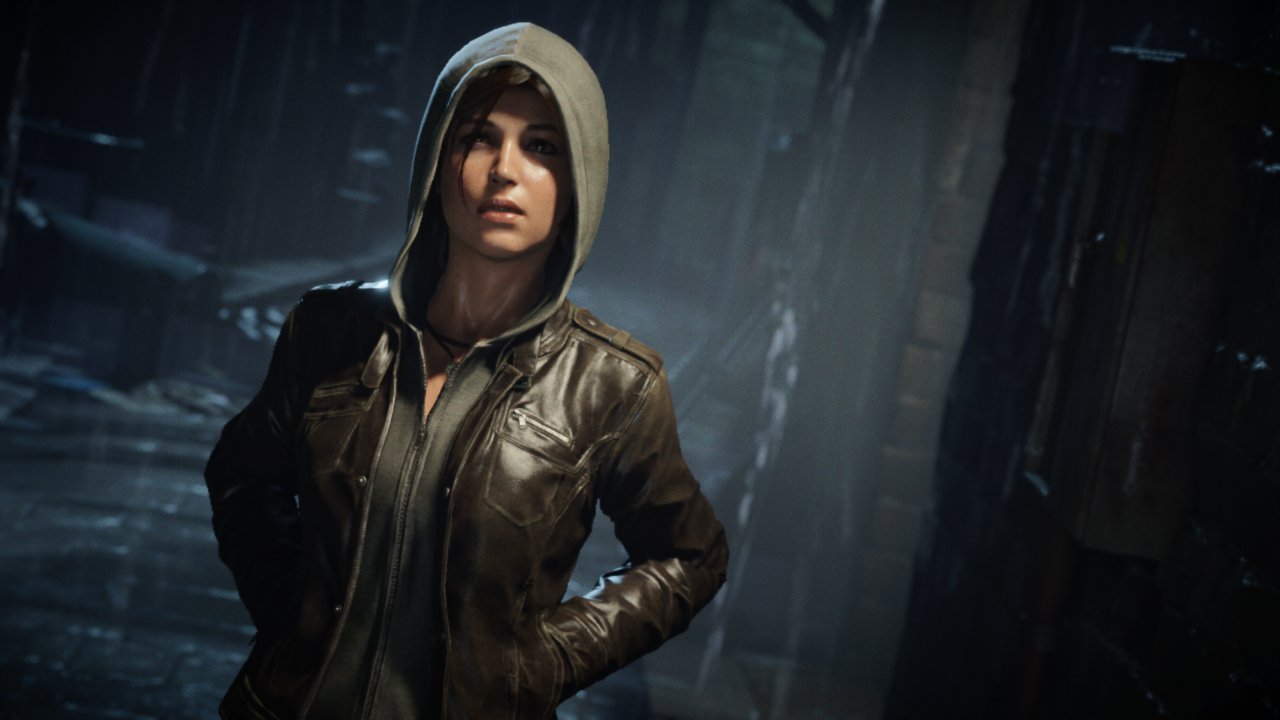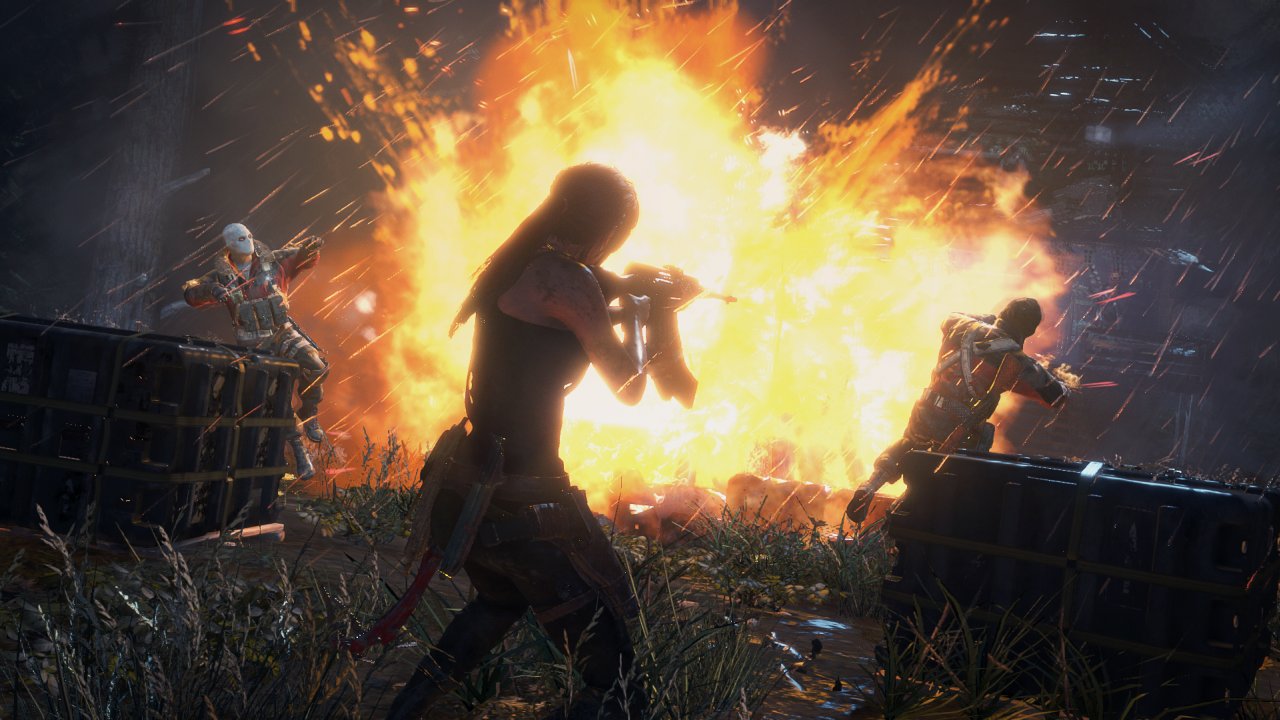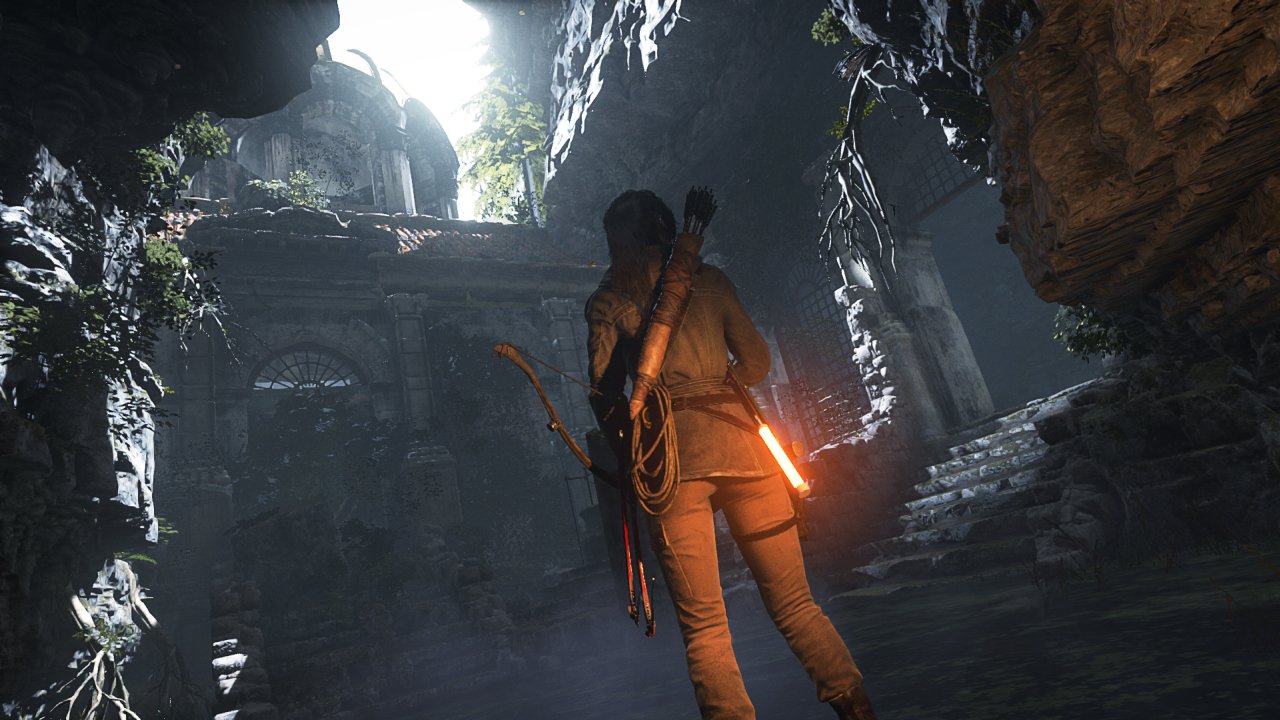Rise of the Tomb Raider Review
Action adventure sequel offers familiar mechanics, unsatisfying narrative
Crystal Dynamics’ reboot of the Tomb Raider franchise provided a unique opportunity for the universe of Lara Croft. Creating a more grounded basis for Lara’s adventuring skill set, 2013’s Tomb Raider attempted to take the caricature of Lara Croft and make her human. While it wasn’t a perfect effort, it does a far better job of fleshing out the character than this year’s sequel, Rise of the Tomb Raider. Mechanically, the new title largely resembles its predecessor. Some smart design choices manage to pull the pieces together and make for an okay second entry of this new series.

Rise of the Tomb Raider tells the story of Lara’s quest to restore her father’s name and legacy by finding a holy relic called The Divine Source. Much of the story is hidden in texts found throughout the game, but The Divine Source is a shard-like rock which grants people immortal life. It was created by a person referred to as The Prophet, who earned a huge following because he could make them immortal, and led them to Siberia to escape an ancient order named Trinity. It was hard for me to discern who was crazier, a prophet who led his people to Siberia to basically be entombed for eternity in order to protect a relic they created, or the religious zealots pursuing him. Crystal Dynamics wants you to sympathize with The Prophet and hate Trinity even though they’re both faith-based military sects fighting over a treasure. It’s so ham-fisted, the message almost comes off as “It’s okay to die for what you believe in, as long as what you believe in is real”. Keep in mind all of this is back-story, used to frame Lara’s adventure. But the majority of the story is stuck in this historic conflict, rarely pushing forward with any modern day narrative except for these two sects fighting each other. The mixed messages and narrative tangents make Rise of the Tomb Raider an even less satisfying adventure tale than the first game. But the biggest problem is Lara herself.
It’s not that I expected the follow up to the Tomb Raider reboot to be an amazing story of intrigue and depth. While the first game attempted to explore Lara’s humanity, her growth was poorly paced and her story of survival quickly turned into one of her killing everything. But at least the previous entry attempted that growth. In Rise of the Tomb Raider, Lara is so wooden and poorly developed, at the best of times she feels like nothing more than a lens through which to tell the story. At the worst of times, her murderous zeal makes one question whether or not she really is the hero of this tale. While the villains attempt to find the Divine Source to save someone they love, Lara’s more in it for herself and her good name. We know we’re supposed to hate the military corporation Trinity because the game tells us to, but their dogmatic quest seems no different from Lara’s.
The biggest missed opportunity here is to continue fleshing Lara out as a character. In the reboot, the game’s serious tone seemed a reflection of the story it was trying to tell. Rise of the Tomb Raider is so poorly explained, it would almost make more sense if Lara was wise cracking jokes after each life-threatening event. This sequel’s narrative is in desperate need of side characters from the previous game so someone can remind us why we’re supposed to like Lara. The only returning character is Jonah (if you remember who he is without reading a Tomb Raider wiki) while Sam, Lara’s supposed close friend who she spent all of the previous game trying to rescue, isn’t even mentioned.

Camilla Luddington does the best she can lending her voice to Lara, but her supporting cast never gets on level. It’s hard to say if the voice acting isn’t great or if the writing is impossible to deliver with sincerity, but I tend to think it’s the former. The soundtrack draws its themes from the first game and does a nice job of subtly adding some emotion to the quiet scenes. The game looks alright, but it’s just alright. There’s a lot of stock bearded white henchmen in every scene, proving that there’s clearly some shuffling around of assets from cutscene to cutscene. Lara’s new face looks fine. She’s a little more emotive than in the previous game, but I was never blown away by the technology. Compared to other games that use cinematic storytelling, Rise of the Tomb Raider is solid, but not incredible.
Luckily, the core mechanics from 2013’s Tomb Raider are just as fun as they were the first time around. Lara’s adventuring will earn her experience which results in skill points that can be used for special abilities. A lot of these elements will be familiar to previous Tomb Raider players. The categories of skills are divided into Brawling, Hunting, and Survival. They allow you to use your weapons to finish off enemies more quickly, give you the ability to drop down on enemies and assassinate them from high perches, or improve the amount of resources that can be gathered. The weapons are familiar too. Unless you go hunting for the upgrades, you’ll get a standard pistol, bow, shotgun, and assault rifle. You can upgrade these weapons to do more damage or fire more rapidly, but it’s all pretty standard.
I also really liked the language mechanic introduced in Rise of the Tomb Raider, though there isn’t much you can do with this skill. Finding murals, notes, and other text in foreign languages will not only earn you experience, but will also level up your ability to read foreign languages. Hunting for these writings is fun and ideally the more you improve your language skill the more secrets you’ll be able to unlock through translation. But I never really found a time when these language skills were necessary. It’s a nice attempt for Crystal Dynamics to try and make the game more intellectual than simply killing people and leaping around caves, but it never seemed to pay off.
Also, much like the previous game, you can collect items in order to upgrade your weapons and build new ones. There are usually animals to hunt, but I never needed to go out of my way to make sure I was well-supplied. You can find feathers in nests, skin deer hides, and use the parts of the other animals to upgrade your equipment, but between the other collectibles (explorer packs and hidden chests) I was constantly well supplied. There’s a nice, steady progression in Rise of the Tomb Raider; I never found myself scouring every nook and cranny for materials to simply keep myself supplied with arrows and bullets, but at the same time if you waste too much ammo in combat things can get dicey.

One of the my least favorite things in the Tomb Raider reboot were times when Lara would be pinned down and forced to shoot it out with waves upon waves of enemies. Rise of the Tomb Raider cuts down on a lot of this. The game throws enemies at you in a more tactical way. As they seek to flank and flush you out of cover, you’ll find yourself pressed to use the environment far more than before. It can occasionally be frustrating; you’ll encounter heavily armored enemies and at times you’ll be under so much fire that your controller will rumble non-stop throughout a fight.
Encounters feel tighter and resolved more quickly (for better or worse). The foes never let you get comfortable as they press on, armed to the teeth. This flowing combat forces you to more quickly adapt to what the enemy is doing. When armored melee enemies close in, you’ll want to pull out your shotgun. Enemies that are hiding need to be flushed out by crafting explosives with the material surrounding you. Players will have to quickly dodge, plot, and adapt. This combat allows the game to remain challenging even when only encountering a handful of enemies. The message is pretty clear: it’s quality not quantity that makes for good battle. Rise of the Tomb Raider is a nice step in encounter design for Crystal Dynamics and never did I feel like I was being forced into boring shooting-gallery combat.
The same can’t be said for the game's stealth. The bow is still a good friend to have, but a lot of level design feels like it is pressing you into fights. It’s hard to find enemies who are alone. Taking out enemies can take a long time if you aren’t pulling them into cover. A couple of important skills can help with your stealth, but unless you really focus in on that type of experience, I’d be ready to engage in firefights more often than not. Again, it’s not so bad considering how much more thought has gone into the combat.
When you’re not shooting bad guys, you’re exploring one of the game’s handful of areas. Rise of the Tomb Raider is supposedly two to three times bigger than the previous game, but it never felt expansive or large. You can fast travel from base camp to base camp, but unless I was changing from one area to another it never felt like a fast-travel was necessary. Rise of the Tomb Raider isn’t a small game, but it won’t wow you with its size.
The platforming in Rise of the Tomb Raider struggles at first. There’s not many skills Lara uses that weren’t employed in the reboot and the old abilities quickly grow stale. It isn’t until later in the game that Crystal Dynamics really start to show some confidence in their design and mix things up a bit, throwing different challenges at the player in exciting escape sequences. Lara’s final climb is a fine showcase of this, it’s just a bummer that it isn’t until the end-game climactic moment that we get that adrenaline rush one would expect on a constant basis from an action-adventure game of this nature.

The best part of Rise of the Tomb Raider is the optional challenge tombs. Here, players truly earn their explorer stripes with these side quests by first locating the hidden tombs, then figuring out the puzzles which strike the perfect balance between being difficult and enjoyable. You might feel stumped from time to time, but the rewarding feeling of completion is totally worth the struggle. It’s unfortunate, that just like in the previous game, this content is shoved off to the side and not highlighted as it should be. Tomb Raider needs more of these great puzzles.
After you’ve finished Rise of the Tomb Raider’s story (which is about 15-20 hours) the game offers some replay value with its Expeditions mode. There are a few things to do in Expeditions, the most simple is replaying story chapters of the game to look for more treasures as you seek to indulge in your completionist tendencies. You can also play missions to help The Remnant (one of your allies in the story). These missions can be custom built by players and shared. Doing all of this earns you currency that you can use to purchase card packs which allow players more skills and options in the Expeditions mode. It all seems like an effort to streamline replaying the game. While it’s a nice though, hopping into a custom built mission or replaying a story chapter to earn high scores and collectible cards seems like a hollow venture. The game shows you the high scores of your friends, but I’ve never thought of Tomb Raider as a franchise that needs leaderboards. I have trouble imaging players interacting with this mode in a significant way.
Rise of the Tomb Raider is a totally serviceable sequel to the 2013 reboot. The mechanics that made the first game interesting are back, core gameplay remains fun, and the design is more thoughtful than its predecessor’s. It doesn’t tie together as nicely though; Lara’s story is far less interesting and her character undeveloped. In the end, it’s surprising to see the narrative quality take a step backwards. When so many other games are raising the bar on cinematic experiences, Rise of the Tomb Raider just doesn’t compare. Though, anyone who enjoyed the arrow shooting, tomb raiding, and extreme rock-climbing from the first go-round will assuredly find plenty to enjoy in Lara’s latest adventure.
 Comments
Comments


















